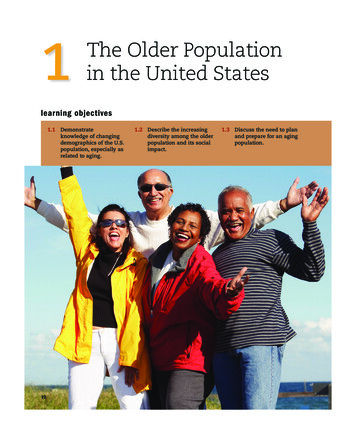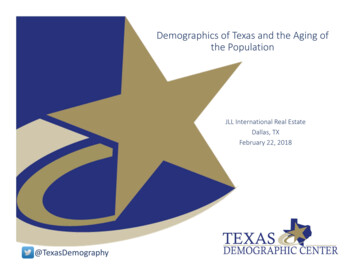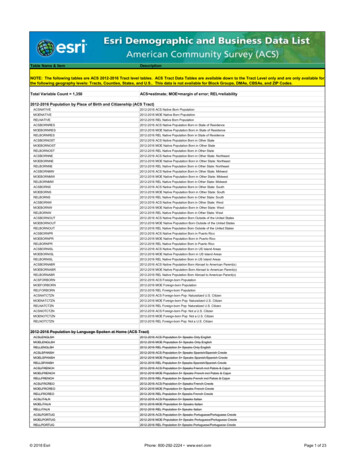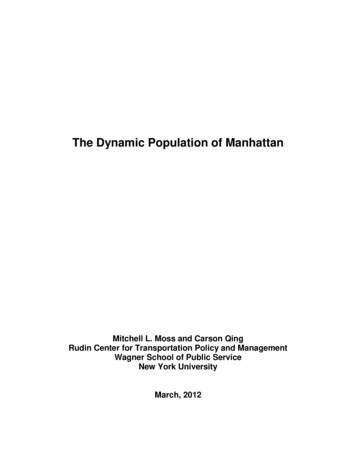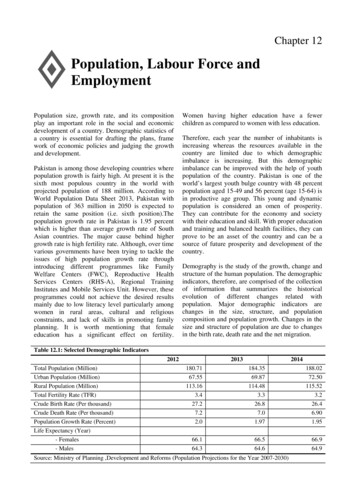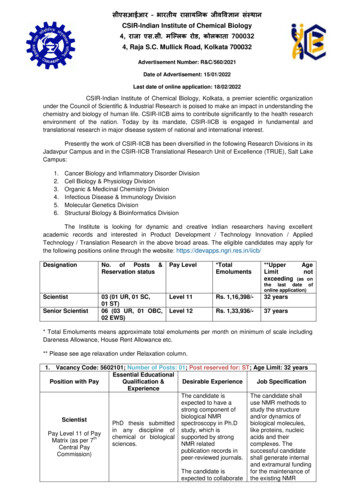
Transcription
Division of Community andPopulation Health Report
Table of ContentsExpanding Our Reach to Help More Neighbors . . . . . . . . . . . . . . . . . . 1Community and Population Health Leadership . . . . . . . . . . . . . . . . . 2About NewYork-Presbyterian . . . . . . . . . . . . . . . . . . . . . . . . . . . . . 3Division of Community and Population Health: Our Mission . . . . . . . . . 4Clinical Services: Ambulatory Care Network . . . . . . . . . . . . . . . . . . . . 6Ambulatory Care Network Nursing . . . . . . . . . . . . . . . . . . . . . . 11Telehealth . . . . . . . . . . . . . . . . . . . . . . . . . . . . . . . . . . . . . . 13Community Health Programs . . . . . . . . . . . . . . . . . . . . . . . . . . . . 14ANCHOR (Addressing the Needs of the Community ThroughHolistic, Organizational Relationships) . . . . . . . . . . . . . . . . . . . .15Behavioral Health Clinical Services (Outpatient) . . . . . . . . . . . . . 16Building Bridges, Knowledge and Health Coalition . . . . . . . . . . . . 18Center for Community Health and Education . . . . . . . . . . . . . . . 19CCHE: Family Planning Program and Young Men’s Clinic . . . . . . . . 20CCHE: School-Based Health Center Program . . . . . . . . . . . . . . . . 21CCHE: Uptown Hub . . . . . . . . . . . . . . . . . . . . . . . . . . . . . . . . 22Center for Community Health Navigation . . . . . . . . . . . . . . . . . 24Centering Pregnancy Program andThe Carnegie Hall Lullaby Project . . . . . . . . . . . . . . . . . . . . . . . 26Collaborator Network Workforce Development and Training . . . . . 27Choosing Healthy & Active Lifestyles for Kids (CHALK) . . . . . . . . 28Compass . . . . . . . . . . . . . . . . . . . . . . . . . . . . . . . . . . . . . . . 30Community-Based Sexual Health . . . . . . . . . . . . . . . . . . . . . . . 31Cultural Competency and Health Literacy Workgroup . . . . . . . . . . 35Health & Housing . . . . . . . . . . . . . . . . . . . . . . . . . . . . . . . . . 36Health for Life . . . . . . . . . . . . . . . . . . . . . . . . . . . . . . . . . . . 37Health Home . . . . . . . . . . . . . . . . . . . . . . . . . . . . . . . . . . . . 38Healthy City Kids . . . . . . . . . . . . . . . . . . . . . . . . . . . . . . . . . 39Lang Youth Medical Program . . . . . . . . . . . . . . . . . . . . . . . . . 40Manhattan Cancer Services Program . . . . . . . . . . . . . . . . . . . . .41NewYork-Presbyterian Performing Provider System Impact Grants . 42Outreach Program . . . . . . . . . . . . . . . . . . . . . . . . . . . . . . . . 43Reach Out and Read Program . . . . . . . . . . . . . . . . . . . . . . . . . 44The Family PEACE (Preventing Early Adverse ChildhoodExperiences) Trauma Treatment Center . . . . . . . . . . . . . . . . . . . 45Turn 2 Us (T2U) . . . . . . . . . . . . . . . . . . . . . . . . . . . . . . . . . . 46Waiting Room As a Literacy & Learning Environment (WALLE) . . . . 47Women, Infants, and Children Program (WIC) . . . . . . . . . . . . . . . 48Workforce Development and Training: Payment ReformResources and Support . . . . . . . . . . . . . . . . . . . . . . . . . . . . . 49Education and Training . . . . . . . . . . . . . . . . . . . . . . . . . . . . . . . . . 50Health Reform . . . . . . . . . . . . . . . . . . . . . . . . . . . . . . . . . . . . . . 53Healthcare Networks . . . . . . . . . . . . . . . . . . . . . . . . . . . . . . . . . . 54
Expanding Our Reach to HelpMore NeighborsThe year 2018 was one of growth and expansion for the Division ofCommunity and Population Health, enabling us and our collaborators to providehealthcare services, education, and linkage to care to more people than ever before — including thosewho live near other hospitals within the NewYork-Presbyterian regional network. Efforts such as these linkresidents of our communities with high-quality health care, as well as encourage them to advocate fortheir own health and that of their family members.NewYork-Presbyterian has a long history of caring for our community. In addition to providing care toresidents of Washington Heights and Inwood, the Upper East Side, East Harlem, and northwest Queens,we can now meet the needs of other residents through initiatives such as: The Center for Community Health Navigation, which expanded their work to NewYork-PresbyterianBrooklyn Methodist Hospital and NewYork-Presbyterian Queens. The Uptown Hub, a Youth Opportunity Hub that empowers members to advocate for themselvesand reach their personal, academic, and career aspirations. Health for Life — a comprehensive weight management program for children, teens, and theirfamilies — was expanded to the Ambulatory Care Network Broadway Practice. Choosing Healthy & Active Lifestyles for Kids (CHALK) expanded to the George WashingtonHigh School Campus and now provides services for adolescents. We are investing in telehealth to increase access to our services and have achieved favorableresults in this year’s pilot programs in neurology, dermatology, pharmacy, and behavioral health. We are reaching more individuals than ever before through our targeted outreach efforts, withmore than 4,000 people served in 2018 through a variety of public health initiatives.Our teams are increasingly identifying and addressing social determinants of health outcomes, such as thepresence of trauma in the home. At the Second Annual Clergy Summit, members of the Building Bridges,Knowledge and Health Coalition engaged 100 faith-based members who heard a minister, a local politician,and doctors from the Family PEACE program and NewYork-Presbyterian psychiatric practices address thisyear’s theme: Trauma – Compassionate Care and Communities of Faith. ANCHOR (Addressing the Needs ofthe Community through Holistic Organizational Relationships) staff members conducted a survey to betterunderstand health practices and social determinants of outcomes, with the goal of connecting residents withcommunity-based organizations.This report also details our educational programs, including Pediatric and Adolescent, Adult Medicine, andFamily Medicine residency programs, initiatives led by nurses and advanced practice nurses to educate theircolleagues, and the Lang Youth Medical Program for underserved middle school and high school students.These programs bolster the future of community health by providing guidance for tomorrow’s leaders today.In 2019, we will undergo a Community Health Needs Assessment of our ten campuses, in collaboration withcommunity members, patients, public health experts, and local health officials. We look forward to the resultsof this analysis, which will help guide our public health strategy in the years to come.Sincerely,Paul J. DunpheySenior Vice President & Chief Operating OfficerNewYork-Presbyterian Allen Hospital & Ambulatory Care and Community Health Network1
Community and Population Health LeadershipPaul J. DunpheySenior Vice President &Chief Operating OfficerNewYork-Presbyterian Allen Hospital& Ambulatory Care and CommunityHealth NetworkNelson MesaDavina V. PrabhuAndres NietoVice PresidentAmbulatory Care NetworkDirectorAmbulatory Quality ImprovementDirectorCommunity Health Outreach & MarketingElaine Fleck, MDAssociate Chief Medical OfficerNewYork-Presbyterian AmbulatoryCare Network Associate Clinical ProfessorColumbia University Irving Medical CenterMark Krugman, RNDirector of NursingAmbulatory Care Network2Jennie OverellDirectorAmbulatory Care NetworkNewYork-Presbyterian/ColumbiaAlpa PrasharDirector of Operations
About NewYork-PresbyterianNewYork-Presbyterian is one of the nation’s most comprehensive, integrated academichealthcare systems, dedicated to providing the highest quality, most compassionate careto patients in the New York area, nationally, and across the globe. In collaboration with tworenowned medical schools, Weill Cornell Medicine and Columbia University Vagelos Collegeof Physicians and Surgeons, NewYork-Presbyterian is consistently recognized as a leader inmedical education, groundbreaking research, and innovative, patient-centered clinical care.NewYork-Presbyterian has four major divisions: N ewYork-Presbyterian Regional Hospital NetworkComprised of leading hospitals in and around New York and delivers highquality care to patients throughout the region N ewYork-Presbyterian Physician ServicesConnects medical experts with patients in their communities to expand coordinatedhealthcare delivery across the region N ewYork-Presbyterian Community and Population HealthEncompasses ambulatory care network sites and community healthcare initiatives,including NewYork Quality Care, an Accountable Care y Irving Medical Center622 West 168th StreetNew York, NY 10032212-305-2500NewYork-PresbyterianLower Manhattan Hospital170 William StreetNew York, NY 10038212-312-5000NewYork-PresbyterianAllen Hospital5141 BroadwayNew York, NY 10034212-932-4000Steven J. Corwin, MDPresident and Chief Executive OfficerExecutive Vice Presidentand Chief Operating OfficerEmployeesFull Time EquivalentEmployeesResidents and FellowsAttending PhysiciansTotal PhysiciansNewYork-PresbyterianLawrence Hospital55 Palmer AvenueBronxville, NY 10708914-787-1000NewYork-PresbyterianWestchester Division21 Bloomingdale RoadWhite Plains, NY 10605914-682-910047,2172,5277,73610,263Inpatient StatisticsTotal BedsInpatient DaysDischargesTHE SEVEN-CAMPUS ACADEMIC MEDICAL CENTERNewYork-PresbyterianMorgan StanleyChildren’s Hospital3959 BroadwayNew York, NY 10032800-245-KIDSLeadershipLaura L. Forese, MD ewYork-Presbyterian Hospital NNewYork-Presbyterian Hospital is ranked #1 in New York and a top fivehospital in the nation in U.S.News & World Report’s “Best Hospitals” survey.NewYork-Presbyterian/Weill Cornell Medical Center525 East 68th StreetNew York, NY 10065212-746-54542018 FACTS AND ient StatisticsTotal Outpatient Visits3,428,630Ambulatory Surgeries155,399Emergency Department693,454Visits (includes ED admissions)Neighborhood StatisticsMedical Group VisitsClinic VisitsTelehealth Visits2,326,092986,070106,736Payor MixMedicare36.1%REGIONAL HOSPITAL erianBrooklyn Methodist Hospital506 6th StreetBrooklyn, NY 11215718-780-3000Self PayNewYork-PresbyterianHudson Valley Hospital1980 Crompond RoadCortlandt Manor, NY 10567914-737-9000NewYork-PresbyterianQueens56-45 Main StreetFlushing, NY 11355718-670-1065For more information, visit www.nyp.org and find us on Facebook, Twitter, Instagram,YouTube and Healthmatters.nyp.org1.2%Find a Doctor Referral Call Center 77-NYP-WELL8www.nyp.org3
Division of Community andPopulation Health: Our MissionNewYork-Presbyterian’s Division of Community and PopulationHealth collaborates with community, hospital, and academicorganizations to improve the health and well-being of children,adolescents, and adults in the communities we serve.The Division conducts a comprehensive community needs assessment every three yearsto increase our understanding of the health and social needs of the communities wereach. Based on the results, we create a community service plan outlining health prioritieswe will address and our approach to each one. We leverage NewYork-Presbyterianand community resources to decrease local health disparities through innovativepopulation health initiatives, care provider training, scholarship, and research that arecollaboratively developed, executed, assessed, and maintained. The combination ofNewYork-Presbyterian’s skills and resources with the talents, energy, and resources ofour community partners enables us to achieve our goals. Together, we aim to reducehospital length of stay, avoidable emergency department visits, inpatient admissions, andreadmissions within 30 days. These efforts also support initiatives that: Empower individuals and families to promote health and wellness Better navigate local systems of care and local resources Improve school readiness and academic achievement4 Ultimately improve quality of life
NewYork-Presbyterian has a history ofworking to enhance the health of individualsin our surrounding communities.A Long-Term Commitment to Our NeighborsNewYork-Presbyterian has a history of working to enhance the health of individuals in oursurrounding communities. As one of the largest academic medical centers in the country,we leverage our patient care, research, and educational resources to address healthinequities at the local level. In the Washington Heights and Inwood (WHI) communities,we and our community collaborators have united for more than 30 years to build theinfrastructure needed to bolster and maintain vital population health initiatives.Who We ServeThe WHI communities are highly diverse. More than 70% of residents identify asHispanic and have encountered cultural, social, and language obstacles to care. WHI alsoexperiences a disproportionate health burden compared to the rest of New York City. Onein three residents lives below the poverty line. Diabetes, asthma, heart failure, depression,and childhood obesity are major health concerns. WHI is a federally designated“empowerment zone,” indicating that it has one of the greatest concentrations of povertyin the United States and is eligible for special grants, loans, and investments to improveresidents’ lives.Some 524,000 people live in the NewYork-Presbyterian/Weill Cornell Medical Center area,which includes communities of the Upper East Side of Manhattan, East Harlem, andnorthwest Queens. Twenty-five percent of the NewYork-Presbyterian/Weill Cornell regionis of Hispanic descent, with an additional 11% African American and 11% Asian/PacificIslander. Thirty-one percent of the population in this region is foreign born. While Englishis the most common language, 22% report Spanish as their primary language. There aremore than 125,000 people on Medicaid living in the NewYork-Presbyterian/Weill Cornellarea, and 13% do not have health insurance.5
Clinical Services: Ambulatory Care Network6
The Ambulatory Care Network touches all of ourcommunities, making it easier for everyone toaccess high-quality, affordable, patient-friendly carein their own neighborhoods.NewYork-Presbyterian’s Division of Community and PopulationHealth provides clinical services through its Ambulatory CareNetwork (ACN), which includes 14 primary care sites, seven schoolbased health centers, 13 mental health school-based programs, andover 60 specialty practices. We serve generations of families fromacross New York City who represent a wide array of nationalities andethnic and religious backgrounds.The Ambulatory Care Network touches all of our communities, making it easierfor everyone to access high-quality, affordable, patient-friendly care in their ownneighborhoods. We provide a broad range of services. When specialized care orhospitalization is required, our compassionate and helpful staff coordinate patients’ needswith the extraordinary range of specialty programs and resources available at NewYorkPresbyterian.All of our Ambulatory Care Network primary care practices are Patient-Centered MedicalHomes, where patients receive care from a team of dedicated healthcare providers,led by their primary doctors. With patient participation, the medical team coordinatesand manages treatment plans so patients and their families receive the best care. Withthe support of State funding and generous donors, we have continued to enhance ourclinical care by implementing innovative programs targeting specific health needs in thecommunities we serve. We have embedded these programs seamlessly into our practiceoperations, and they function in collaboration with our clinical staff to ensure our patientsreceive the care they need. The following is a description of some of our clinical offerings.Ambulatory Care Network Primary Care ImprovementThrough DSRIP, there have been a number of targeted efforts to improve the quality of careand health outcomes for high-risk and high-cost adult and pediatric populations with complexcare needs in the Ambulatory Care Network’s primary care practices. Culturally competentand family-centered nurse care managers, social workers, psychiatric nurse practitioners,and community health workers (CHWs) have been augmented and embedded in practicesto coordinate care. Collaboration has increased among providers and community-basedorganizations to meet the needs of the population. Palliative care screening, risk assessment,and dedicated staffing have been integrated within practices to address unmet palliative careneeds. More than 16,000 adults and 10,000 patients have been reached, and over 1,600 havereceived palliative care.The NewYork-Presbyterian Performing Provider System has numerous programs across theHospital and collaborator network to connect patients and families with the care they need.PRIMARY CARE LOCATIONSNewYork-Presbyterian/Weill Cornell Medical CenterWeill Cornell InternalMedicine AssociatesWright Center1484 First Avenue, 1st FloorNew York, NY 10075Irving Sherwood Wright Centeron Aging525 East 68th Street, Payson 2New York, NY 10065Weill Cornell Internal MedicineAssociates505 East 70th StreetHelmsley Tower, 4th FloorNew York, NY 10021Pediatric Practice505 East 70th StreetHelmsley Tower, 5th FloorNew York, NY 10021Women’s Health Practice505 East 70th StreetHelmsley Tower, 5th FloorNew York, NY 10021The Center for Special StudiesGlenn Bernbaum Unit525 East 68th Street, Baker 24New York, NY 10065The Judith Peabody Wellness CenterDavid E. Rogers Unit53 West 23rd Street, 6th FloorNew York, NY 100107
Clinical Services: Ambulatory Care NetworkBehavioral Health (BH) Crisis ProgramHeather Straccia MD, CTI, Clinical Leadhs2736@cumc.columbia.eduPRIMARY CARE LOCATIONSWarren Y.K. Ng, MD, MPH, Medical DirectorOutpatient Behavioral Healthywn9001@nyp.orgSupported by DSRIP initiatives, the BH Community Crisis Stabilization Programtransformed our outpatient psychiatric services by developing two new keyinterventions: a Critical Time Intervention Team (CTI) and BH Crisis HUB. The BH CrisisHUB and Treat-Link-Connect Brief Crisis Treatment Program were integrated intoAdult Outpatient Behavioral Health Services. These programs target patients withcomorbid behavioral health, substance use, and social determinants of health needsby providing rapid triage, assessment, and linkage to comprehensive services, utilizinga multidisciplinary team in partnership with community-based organizations andproviders. The CTI team assists patients in potentially destabilizing periods of transition as wellas intensive behavioral health services in the community for three to nine months.Most patients have co-occurring substance use issues, chronic medical conditions,unstable housing, and psychosocial stressors. Since the program began in 2017, the CTIteam has cared for 124 patients, and the 30-day hospital readmission rate has declinedfrom 50% to 19%. Patients with chronic medical conditions, including those that hadnot been effectively treated, have received extensive health management and linkageto appropriate medical care. The BH Crisis HUB has served over 900 patients and provides effective linkage tooutpatient medical and psychiatric/substance use treatment.Tobacco Cessation ServicesDavid Albert, DDS, MPH, Clinical Leaddaa1@cumc.columbia.eduJulie Chipman, Program Managerchipmaj@nyp.orgTobacco Treatment Services (TTS) facilitates adoption of tobacco treatment byAmbulatory Care Network and Hospital clinicians. The team — patient navigators andnurse practitioners who are dedicated to TTS or are content experts who integrateTTS into their primary care roles — has engaged nearly 3,700 ACN patients in tobaccotreatment. In 2018, the team trained providers and medical assistants on tobaccotreatment and engagement across the ACN and continued outreach activities in thepractices. TTS staff organized a texting campaign with ACN adult patients and tablingevents across the clinics in November to raise awareness about The Great AmericanSmokeout. The program expanded into areas with a high concentration of tobaccousers, including the Pulmonology Clinic and Adult Psychiatry Clinic; developed neweducational materials on hookah and other tobacco products; and introduced the useof carbon monoxide monitors (an important diagnostic tool in tobacco treatment andprevention education) into the ACN. The TTS team participated in community activities,including tobacco treatment educational workshops, health fairs, and sponsorship ofan annual Tobacco Treatment Specialist training for hospital and community-basedorganizations in the tri-state area.8NewYork-Presbyterian/Columbia University IrvingMedical CenterAssociates in Internal Medicine(AIM)622 West 168th Street, 2nd FloorNew York, NY 10032Audubon PracticeObstetrics and Gynecology/Pediatrics21 Audubon AvenueNew York, NY 10032Broadway Practice4781-83 BroadwayNew York, NY 10034Comprehensive Health ProgramInfectious Disease Clinic (IDC)180 Fort Washington Ave., 6th FloorNew York, NY 10032Charles B. RangelCommunity Health Center534 West 135th StreetNew York, NY 10031Herman “Denny” Farrell, Jr.Community Health Center610 West 158th StreetNew York, NY 10032The Washington HeightsFamily Health Center575 West 181st StreetNew York, NY 10033
Health Information Exchange ExpansionSPECIALTY PRACTICESPatricia Hernandez, LCSW, Managerpah9051@nyp.orgThe Division of Community and Population Health uses the Health Information Exchangeto support team-based care across the Hospital and the network of community-basedcollaborators. The Division employs Healthix — a New York State-sponsored informationexchange platform — to enhance access to patient records across health providers; improvereceipt of clinical event notifications (targeted messages on patients’ use of emergencydepartments, inpatient facilities, and so forth); and improve community provider access toa patient’s health data from across New York State. To date, the Division has granted accessto 14 community-based collaborators, with three more organizations scheduled to go livein 2019. In addition to working on granting access to more collaborators, the Division isfocusing on adoption and usability across the network of collaborators.NewYork-Presbyterian/Weill Cornell Medical Center525 East 68th StreetNew York, NY 10065Cardiology646-962-5558Dentistry (adult) 212-746-5190Transitions of Care ProgramLeslie Chiu, Managerlma9008@nyp.orgSame Day Access Center21 Audubon Avenueat West 166th Street, 1st FloorNew York, NY 10032212-342-4700Claudia Beck, Clinical Leadcbb9003@nyp.orgThe Transitions of Care (ToC) program strengthens continuity of care between NewYorkPresbyterian inpatient units and subsequent settings to reduce the risk of avoidable30-day readmissions to the hospital and/or emergency department. The ToC modeloperates at NewYork-Presbyterian Allen Hospital, Columbia University Irving MedicalCenter, Weill Cornell Medical Center, and Lower Manhattan Hospital. The goals of theprogram are to identify and engage Medicaid patients at increased risk for readmissionand to provide education for these patients and their caregivers on disease and selfmanagement; facilitate timely follow-up with primary care provider(s); and coordinatemedical and social service needs to overcome barriers to safe transitions. Among 30-daycare transitions in 2018, 594 patient discharges were reached, and there were 833 highutilizer discharges through the MAX Series at NewYork-Presbyterian/Columbia — a NewYork State-sponsored initiative to improve care pathways for high utilizers of inpatientcare. There was a 4% reduction in the 30-day readmission rate from 2016-17 (40%) to2018 (36%). The NewYork-Presbyterian/Columbia team expanded on previous MAXSeries efforts at NewYork-Presbyterian/Weill Cornell, implementing new assessmentsby Emergency Department care coordinators and social workers to identify drivers ofutilization and establish daily huddles to link patients with various community teams.The ToC team also expanded in October 2018 to include an embedded care coordinatorand part-time outreach specialist employed by ACMH, Inc., an agency focused on patientswith behavioral health 46-4500NewYork-Presbyterian/ColumbiaUniversity Irving Medical Center622 West 168th StreetNew York, NY 10032866-463-2778Allergy, Audiology, Dermatology,ENT (adult and pediatric),Neurology (adult and pediatric),Nutrition, Ophthalmology,Orthopedics (adult and pediatric),Urology (adult and pediatric),Pulmonary Medicine, RehabilitationMedicine, Speech PathologyGrants ReceivedTotal Grant Awards in 2018: 14,358,486Includes both government andfoundation grant support9
Clinical Services: Ambulatory Care NetworkAmbulatory Care Network Community PracticesCOLUMBIA UNIVERSITY VOLUME BY PRACTICE – 2018 VISITSPRIMARY CAREVISITSVC3 CLINICSAIM Group68,455VC3 - Allergy866Audubon34,330VC3 - Ortho7,110Broadway40,437VC3 - Pediatric Neuro1,409Farrell23,834VC3 - Pediatric Ortho1,363Rangel19,853VC3 - Psychiatry1,447Urgicare Center10,470SUBTOTAL VC312,195Washington Heights34,948VC10 CLINICSVISITSVC10 - Chest2,182VC10 - Neurology3,791SUBTOTAL PRIMARY CARESPECIALTY CAREAudiology232,327VISITS1,166VC10 - NeurosurgeryVISITS562Child Advocacy320VC10 - Newborn1,854Colposcopy855VC10 - Newborn Nutrition1,048VC10 - Nutrition1,092VC10 - Otolaryngology4,565Comprehensive HealthDermatology19,1699,574Family Planning23,288Ft. Washington2,990Movement Disorder19,399PEACE Program2,165ThyroidSUBTOTAL SPECIALTY CARE1,117SUBTOTAL VC1016,211PSYCH CLINICSAdult Psych22,354575102,468Pediatric PsychSUBTOTAL PSYCHPRIMARY CIMA at Wright6,486Wright Center on Aging9,803SUBTOTAL PRIMARY CARE101,617SPECIALTY CAREVISITSAdult DentalBaker CSS12,775Cardiology2,295Chelsea CSS14,196CSS Dental1,574Endocrinology782Fracture431Hand Surgery1892,636VISITSPediatric Dental3,06923,191PFT Lab29,22052,411TOTAL SPECIALTY CARE183,285TOTAL COLUMBIAUNIVERSITY ACN415,612881SUBTOTAL SPECIALTY CARE46,975TOTAL WEILL CORNELL ACN148,592METHADONEAdult HIV SVC.AdultTOTAL METHADONETOTAL NUTRITIONACN-Payor Mix 2018108,147Neurology613OphthalmologySchool BasedVC10 - Special GynWEILL CORNELL VOLUME BY PRACTICE2018 VISITSVISITS1,31427,75529,0691,396Sum of CasesMedicaid Managed49%Medicare Managed14%Medicare FFS11%Commercial11%Medicaid FFS10%Self-Pay2%Other3%
AMBULATORY CARE NETWORK NURSINGNurses in NewYork-Presbyterian’s Ambulatory Care Network are committed to ensuringpatients receive the best care possible. Working to the highest level of their licenses, theyfollow the Professional Practice Model, which is characterized by: A dvocacy. Empowering patients, families, communities, and colleagues to ensureculturally competent and compassionate care. Autonomy. Fostering self-directed practice through critical thinking and accountability. C ollaboration. Promoting interprofessional communication and coordination of patientand family-centered care. E vidence-based practice. Integrating clinical expertise, scientific findings, and patientpreferences to improve outcomes. P rofessional development. Committing to personal, clinical, and scholarly growth tooptimize the patient experience. RNs are certified in their specialties and use the clinicalladder to advance their professional growth, as well as teach nursing staff about varioustopics to enhance their development and competencies. Advanced practice nurseshave their PhDs, DNPs, and Certificates in Mental Health in primary care and otherspecialties.Committee Leadership and ParticipationNurses and advanced practice nurses chair, co-chair, and participate in variouscommittees, such as the monthly Practice Committee, Quality & Patient Safety, MagnetCommittee, and the Advanced Practice Nurses Committee. They are involved in decisionmaking at the practice and department levels, collaborate with various disciplinesto enhance care, and contribute their input regarding practice and policy changes,evidenced-based projects, and standardization of care.Expediting Primary CareThrough the Centralized Clinical Telephone Center, nurses take calls from primary caresites to assist patients with prescription refills, triage care, and speeding the ability tomeet patient care needs, with the goal of decreasing Emergency Department and walk-invisits. This support enables staff at practice sites to deliver care to patients with fewerinterruptions.Supporting School-Based Health CentersSelf-directed advanced nurse practitioners providecomprehensive care, vaccinations, and other servicesto nearly 6,000 enrolled children and adolescents atseven school-based health centers in the community.Nurses collaborate with medical directors, nursing andoperational management teams, school administrators,and other professionals to provide high-quality care tostudents each day.11
Clinical Services: Ambulatory Care NetworkAMBULATORY CARE NETWORK NURSING continuedInterdisciplinary CollaborationNurses collaborate with other disciplines throughout the network on various initiatives,such as:
212-312-5000 NewYork-Presbyterian Morgan Stanley Children's Hospital 3959 Broadway New York, NY 10032 800-245-KIDS NewYork-Presbyterian Allen Hospital



